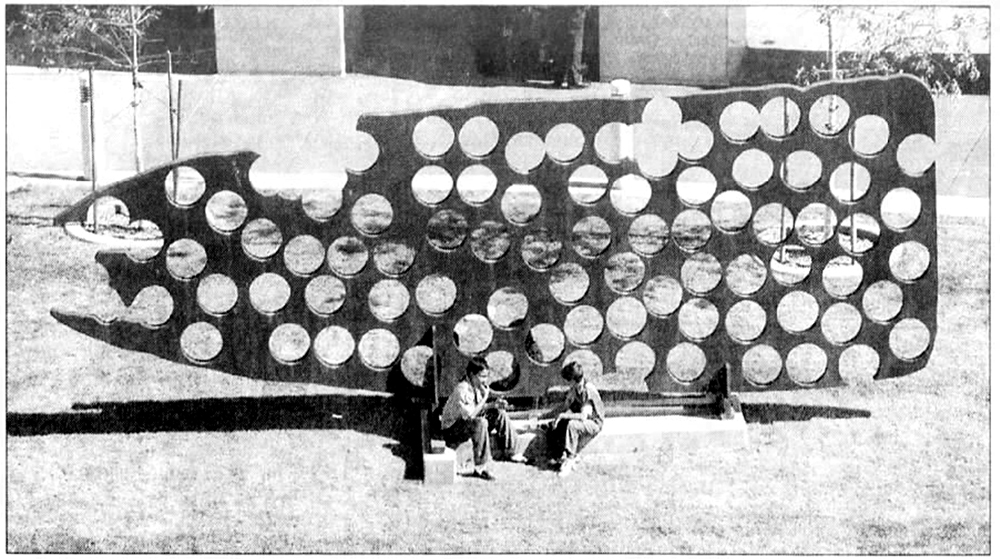Two Bay Area natives honor their
ancestors with public art
Lincoln Cushing 7/16/2024
Recently a Bay Area artist colleague of mine presented a powerful public sculpture honoring her mother. At Berkeley’s Juneteenth celebration Mildred Howard unveiled “Delivered, Mable’s Promissory Note” near the Ashby BART station. The large metal sculpture, based on West African jewelry currency, is a shout-out to Mildred’s mother who fought – and won – to underground the light rail line that would have otherwise disrupted her predominantly Black neighborhood in the 1960s.
Another Bay Area artist did something very much like that in 1996 when Berkeley-born Michael Heizer (1944-) presented a commissioned metal sculpture at the Bruce R. Thompson Federal Courthouse in Reno, Nevada. “Perforated Object #27” was inspired by a Shoshoni artifact created over 1,500 years ago, carved from the horn of a bighorn sheep and perforated by 90 drilled holes. It was discovered in 1936 as part of an excavation led by Michael’s father, U.C. Berkeley anthropology professor Robert F. Heizer (1915-1979) at Humboldt Cave, 100 miles northeast of Reno. Michael’s massive sculpture, like Mildred’s, is a dramatic physical enlargement – 27-foot-long “Object” is 450 times bigger than the 4½” long original. Positive and negative space is a common element in Michael’s works, so the sculpture is accompanied by a rough line of 90 steel rings. Robert was my maternal uncle, who like Mildred’s father, had worked in the WWII shipyards.
Michael’s work did not always formally make historical references. “Platform,” a 30-ton pile of rusty steel commissioned by the Oakland Museum in 1980 and installed at Estuary Park, was purely abstract. Yet even that was described by art critic Allan Temko as “avowedly symbolic, or mythic, recalling the Mayan ceremonial platforms of Chichen Itza, which he saw as a child with his late father.”
Michael began formally connecting his earth work sculptures with indigenous iconography in 1982 with a commission at Buffalo Rock State Park in Illinois. “Effigy Tumili” deliberately evoked Mississippian Culture with mounds and embankments representing a catfish, a frog, a snapping turtle, a waterstrider and a snake. He later began producing sculptures of oversized artifacts in 1989 with a series of immense concrete copies of prehistoric hand tools; in 1993, foreshadowing Mildred’s “Delivered,” he made “Small Pendant.”
Anthropology has seen a severe and legitimate reckoning in the past few years. Robert Heizer wasn’t an activist, yet after beginning as a glorified grave robber – as did most of his colleagues – he was inspired by the spirited demands of the Free Speech Movement and evolved to push the boundaries of his academic field in the right direction. Critic Tony Platt’s recent book The Scandal at Cal gives this nod using a word very much in the news today:
“Heizer was among the earliest academics to use the g-word when describing the state's efforts to exterminate Native peoples in the nineteenth century. ‘No one troubled to name what was happening in California a hundred years ago genocide," he wrote with Theodora Kroeber in 1968.’”
When Michael articulated his goals for his 1982 “Effigy,” he expressed the same respect with the same term: "The Native American tradition of mound building absolutely pervades the whole place, mystically and historically in every sense. Those mounds are part of a global, human dialogue of art, and I thought it would be worthwhile to reactivate that dialogue [ ... ]. It's an untapped source of information and thematic material, it is a beautiful tradition, and it's fully neglected. And it’s from a group of people who were genocided. So, in a lot of ways, the Effigy Tumuli is a political and social comment."
Michael’s life’s work, the massive southern Nevada desert project “City,” has been criticized for lack of environmental and cultural sensitivity. But he’s a major artist who understands that all art, and culture, draws from the deep well of our ancestors.
Thank you, Mildred and Michael, for your work.
Photos:
Robert Heizer with Olmec head, La Venta (Mexico) 1955
Boy Scouts in front of “Perforated Object #27,” photo from the Reno Gazette
My mother, Nancy V. Cushing, and Michael Heizer, 1994, in front of “Perforated Object” at Michael’s Nevada studio. Richard Cushing photo.
Return to Docs Populi / Documents for the Public


